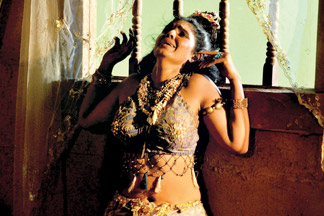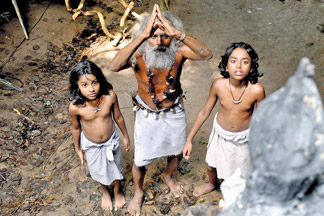|
Film review:
Vijaya-Kuveni: conflicts and controversies
Dr Senarath Tennakoon
There are several literary resources woven around the Vijaya-Kuveni
story. These include the Mahavansa, Pujavaliya, Rajaratbakaraya and
Rajawaliya which are historic accounts while Kuveni Asna, Sihaba Asna,
Vijayaraja Katava, and Siyabasmaldama, are literary works.
 |
|
A scene
from Vijaya-Kuveni |
It is said that Prince Sinhabahu went to Lata, the place of his birth
with his sister Sinhaseevali and built the city called Sinhapura,
Sinhaseevali delivered thirty two twins by him (Sinhabahu her brother)
on sixteen occasions. The eldest son was named Vijaya who was made the
sub king. But Vijaya's bad conduct enraged the people and the king had
to admonish him thrice.
Half shaven
But it was in vain and finally Vijaya had to be banished with his
seven hundred followers, with their heads half shaven and sent to sea in
a ship. Vijaya and his retinue finally landed in Thambapanni or the Land
of Lanka on the day that the Buddha attained Parinirvana (544 BC).
A member of Vijaya's retinue followed a she demon who came in the
form of a bitch, met Kuveni who was at that time engaged in spinning
cotton. He stepped into the pond that was there and became her prisoner.
By deceitful means Kuveni put all the followers of Vijaya imprisoned in
a tunnel.
No harm befell them as they were wearing the Pirith Threads tied by
God Upulvan as instructed by God Sakra as The Buddha on his death bed
had appealed to protect Vijaya and his followers.
Sakra entrusted this task to God Upulvan who came in the form of a
wondering ascetic and tied the Pirith threads around the hands of Vijaya
and his followers while sprinkling Pirith water. Finally Vijaya came
there to find, his followers and suspecting that Kuveni had hidden his
men tried to kill her.
She was powerless as Vijaya was wearing the Pirith Thread. She
released his men. Not only that, she promised to help him to become the
king of the country.
It is said that Kuveni, the she demon assumed a beautiful female
form, enticed Vijaya and lived with him. With the help of Kuveni, Vijaya
stormed a night festival of marriage of demons killed them and built the
city Thamarapanni.
Established villages
He lived with her and they had two children a boy and a girl. The
ministers of Vijaya established villages in various parts of the island.
Upatissa built Upatissagama on the banks of the river Gambhira, Anuradha
built Anuradhagama on the banks of river Kolon.
Three others built Udeni, Uruwela and Vijitha. These ministers
persuaded Vijaya to marry a royal princess and become king. Accordingly,
King Pandu's daughter from Madura together with maidens and people
belonging to eighteen guilds of craftsmen arrived at Mahatota in the
island of Sri Lanka.
 |
|
A scene
from Vijaya-Kuveni |
Vijaya expelled Kuveni together with her two children. Subsequently
Kuveni was killed by the demons as she had betrayed them. Vijaya reigned
for thirty eight years in the city of Thambapanni. (Wijesooriya, 2006).
Sugath Samarakoon and Gyan Ranaweera could have faced challenges in
respect of the setting, characterization, and dialogue (Language or
dialect) in the planning, plot construction, style and viewpoint in the
whole edifice of this cinematic creation.
The socio-economic and cultural environment and the inhabitants
during the time remain hidden in the fog of history and are largely
unclear.
The central characters like Vijaya and Kuveni are legendary. Further
Kuveni has been identified as a sorceresses/Goddess/the last Queen of
the Yaksha clan.
Magical creations
She was believed to have magical powers and she had three breasts and
a crystal tongue. Kuveni appears to come to the forefront in the history
only after her dramatic encounter with Vijaya (Vissya) a prince from
Lata.
The physical and emotional features of Kuveni and Vijaya are largely
unknown.
The bitch/dog that brings Vijaya to Kuveni is believed to be her mate
ShisPathica. Some believe the dog to be one of her magical creations. It
is said that her third breast disappears whenever she meets her husband
and reappears when she is revengeful. She too can change into a Tiger
from Kuveni comes out victoriously after destroying her own clan on a
horse back with a shining Crystal Sword. This is how she destroyed her
clan for the sake of her beloved. Is she not a traitor?
The revenge comes in the form of a Tiger (The Spirit of Kuveni) the
action of the Sword then becomes the Crystal Tongue (Vasantha Kumara,
1983). Many of these features are omitted in the film.
The film shows that in the beginning, the love between Vijaya and
Kuveni was deep and understanding and their married life was moving
smoothly with two children. But the film shows the conspiracy devised by
Upatissa against Kuveni. Kuveni was shown to be consuming human flesh
and she has enticed Vijaya by her magical powers.
Upatissa and other ministers were worried about the kingship that
would shift away from the Aryans to Kuveni's children who were Yakkas.
Further they wanted to marry Aryan princesses and get settled in Sri
Lanka.
The other conflict is between the Yakkas and the Nagas. The Yakkas
were dead against Kuveni for betraying their clan because she became the
consort of a foreigner (Vijaya).
These conflicts are brought out in the film. Sugath Samarakoon has
given a human face to Kuveni devoid of mystical powers. Vijaya too until
towards the end of the film acts in a balanced mental disposition. Even
after chasing away Kuveni he repents and could not enjoy a happy married
life with the Madura princess.
Personal lament
Finally he passes away without a child from his second wife. Sugath
Samarakoon has attempted to highlight that Kuveni has been subject to
unpardonable injustice by Vijaya whereas she should have been fortified
with empowerment.
The film appears to be a personal lament for the innocent Kuveni, as
exemplified by the variety of styles in presenting her character and
life ways. Kuveni is the central character who sacrificed her clan for
love.
She was faithful to Vijaya. She was the key to his happiness. There
was no conflict between them until Vijaya was misled by his ministers.
The unfolding of events pertaining to her pathetic destiny appears to
be inevitable in a male dominated social milieu. The scene of Vijaya
closing the palace door after chasing Kuveni and her children is the
most memorable scene in this film.
Dulani Anurada though new to the silver screen she presents a
remarkable performance as Kuveni. In particular the audience would feel
sorry at the final stage prior to her death by her own clan. Roger
Seneviratna as Vijaya has a difficult role to play as he has to take the
side of his beloved queen as well as that of his team of ministers while
listening to the voice of the two clans (Nagas and Yakkas).
In the beginning he employs Buddhist attitudes and precepts in
meeting problems and justice. Cletus Mendis as Upatissa acts as a
villain and he does justice to his role supported by Buddadasa
Vitanarrachchi and Rinsly Weeraratna.
In fact a large cast of over thirty or so is included in the film.
Apart from the performances the camera by Ayasmantha Hettiarachchi, the
music by Nadika Guruge together with vocal performances by Nanda Malini,
Amarasiri Peiris, Dimitra Ratnayaka and Sugath Samarakoon add artistic
flavour to the film. There were some scenes with expressionistic and
non-naturalistic lightening and music.
Wasantha Vittachchi's stage effects and costumes could have been more
thoughtfully designed as these areas are very grey and challenging
areas. Similarly editing by Ajit Ramanayake could have been a
challenging job as we are unaware of the dialects of the Nagas, Yakkas
and the foreigners (Vijaya and his followers).
It is conjectural whether the characters like Vijaya, Kuveni and
Upatissa could become clearly defined symbols of power, sympathy and
strategic planning respectively. Financial commitment for this massive,
technically superfine production could have been monumental and Sugath
Samarakoon has faced a great challenge and a risk in producing a film
with conflicts and controversies.
The audience would leave the cinema hall after enjoying this film
with an impression of overwhelming powerful, emotional and imaginative
cinematic technology.
|



